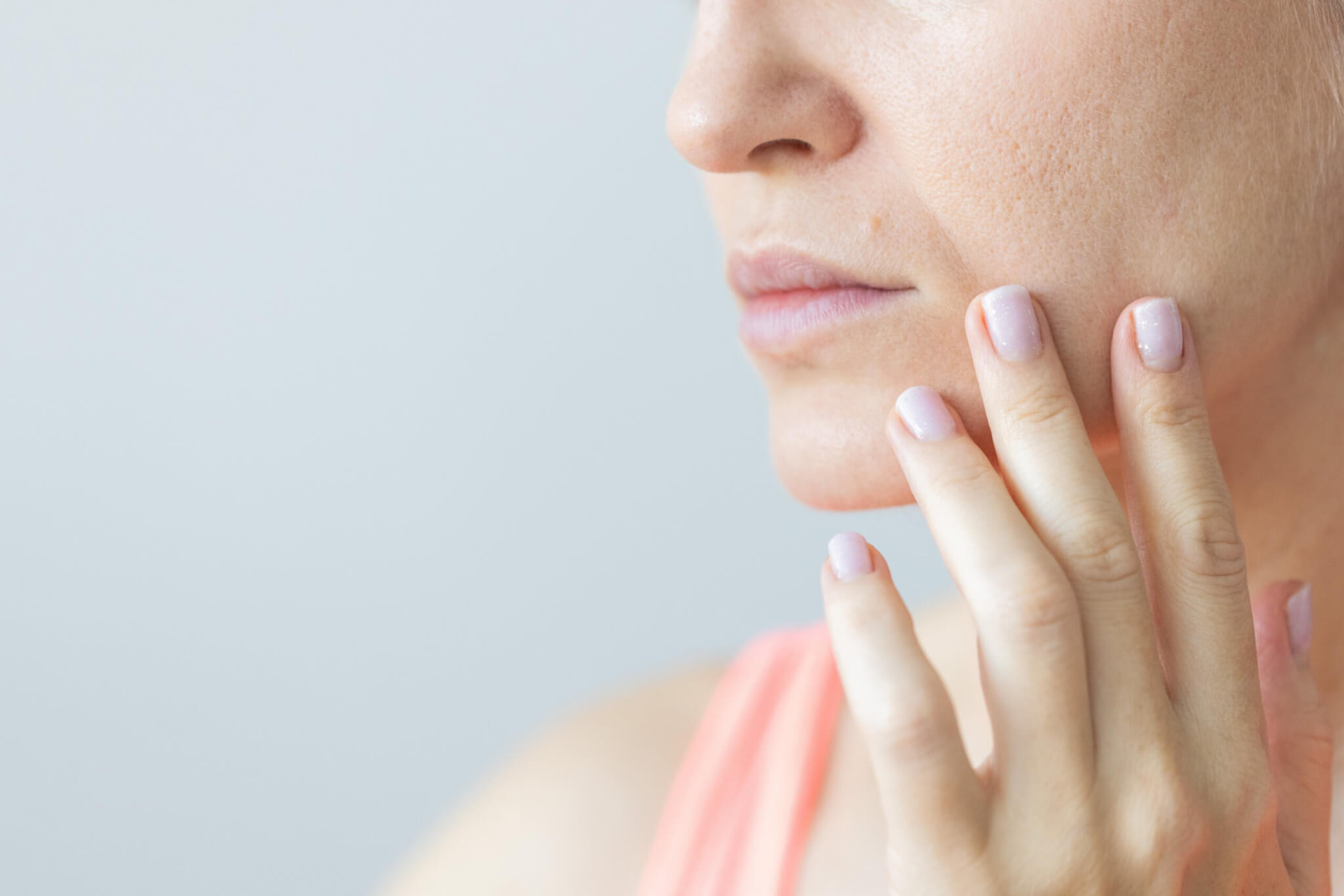Petition to make front-facing phone cameras just a little worse. We’ve all done it: accidentally opening the camera app just to come face-to-face (literally) with every single one of our pores. If you find yourself asking: “Why are my pores so big?” you’re not the only one. Don’t worry, smoother skin is possible.
Pore size is determined by a mixture of genetics and lifestyle factors. This means there’s hope. Depending on your skin type, age, and just how big your pores are (not just how they look in a phone camera or magnifying makeup mirror), a combination of skincare and in-office treatments really can shrink your pores. Still, there are more than a few myths to be aware of.
I looked to the experts for answers. Dr. Jennifer D. Holman, MD, FAAD is a board-certified dermatologist based in East Texas and Mona Seresht, MSPAS, PA-C is a certified physician assistant at Facile. Ahead, the two separate fact from fiction, addressing pore myths and sharing skincare routines to achieve smoother skin.
Why are my pores so big?
At some point in our skincare journeys, we learn to accept the things we can’t change (like the fact that we have pores in the first place). You might wish you could shrink your pores until they disappear, but Seresht notes that understanding—and working with—your pores is key. From there, you can learn to manage various skin conditions, “developing effective skincare routines that promote healthy skin.”
She continues. “[Pores] play essential roles in regulating body temperature by allowing sweat to surface and cool the body. Additionally, pores release sebum, an oily substance that moisturizes and protects the skin.”
Finding out your skin type can provide clues as to how much of your pore size is genetic and how much is caused by external factors. “Just like your skin color is genetic, your skin type, including your pore size, is genetic as well,” says Dr. Holman. “Typically, people with oilier skin who produce more sebum have larger pores. Hormonal factors can also cause you to produce more sebum, and in addition to acne, you can see enlarged pores.”
Another unavoidable factor? Age. While much of our lives get richer and more full as we age, our skin only ages as well as we treat it. “Age gets all of us,” says Dr. Holman. “We lose collagen and elastin as we age and pores become more visible.”
What Causes Large Pores
You’re not just stuck with the pores you’re doled out at birth. How you spend your days also contributes to the appearance of your pores. Some, like your skincare routine, are changeable. Others, like sun exposure, are inevitable—but that doesn’t mean you’re doomed.
Common causes of large pores are sun damage and excessive sebum. “Pores can enlarge when they become congested with debris like dirt, oils, and dead skin cells,” says Seresht. “Excessive sebum production can further stretch and accentuate their appearance.”
Her suggestion? Make sure your skincare routine targets excess sebum. “Maintaining a consistent skincare regimen that includes gentle cleansing, exfoliation, and the use of noncomedogenic products is crucial for minimizing the appearance of enlarged pores and promoting clear, healthy skin.”
Like aging, sun damage impacts pores by breaking down collagen and elastin. “Sun damage causes elastin and collagen breakdown, which can lead to larger pores,” says Dr. Holman. If you need another sign to invest in a good sunscreen, this is it.
Why You May Notice Large Pores on Your Nose
Often, we see large pores on our noses because the sebaceous glands there are bigger. Many of us—guilty!—also find ourselves picking and squeezing at this area when we see blackheads appear. And if you’re trying to overcorrect with pore, you might just be making the problem worse.
The viral hack for large, clogged pores on your nose? French pharmacy favorite, La Roche Posay Cicaplast Baume B5—or any other hydrating, barrier-protecting moisturizer. By hydrating your skin, you prevent excess sebum creation. Cicaplast hydrates and locks in moisture. Even if it’s too thick for you to use for slugging, slather it on your nose to shrink the appearance of your pores.
4 Myths About Large Pores
Myth #1: Pores can “open” and “close”
One of the most pervasive myths is that you need to open up your pores. “They do not have muscles or mechanisms for such movement,” says Seresht.According to Dr. Holman, “Steaming or certain masks may temporarily enlarge pores. These things increase the penetration of certain products in the skin, but pores don’t actually open and close.”
Even these temporary solutions are not fixes, says Seresht. “Beliefs about steam opening pores or pore strips effectively removing debris are widespread but often oversimplified.” While these can temporarily enlarge pores to allow for decongesting your pores or more effective product use, they can also enlarge pores—so be careful.
Myth #2: Pores are filled with dirt
“A common myth about pores is that they are filled with dirt,” says Dr. Holman. “The black material you see inside pores (‘blackheads’ or open comedones) is sometimes oxidized skin proteins. Seeing pores or material inside pores is not because you are dirty or have poor hygiene.”Myth #3: Sunshine will shrink your pores
“Another myth is that a good dose of sunshine will improve the appearance of your pores,” says Dr. Holman. “Sun damage actually breaks down collagen and elastin, leading to the appearance of larger pores.”Myth #4: You can permanently change pore size
As much as certain buzzy beauty products want you to believe this, it’s a marketing misconception at best. “These myths highlight the importance of understanding pore function and adopting evidence-based skincare practices to maintain skin health effectively,” says Seresht.Best In-Office Treatments for Minimizing Large Pores
While you can’t alter pore size permanently, in-office treatments can give you impressive results, fast. Seresht recommends consulting a dermatologist or esthetician to find the right treatment for your skin goals. “The best way to decide what fits your lifestyle, budget, and expectations is to consult with an experienced aesthetic provider.”
How do you know what to look for in a treatment or a practitioner? “Ask for before and after photos and what their experience is treating pore appearance,” she says. “And don’t go for substitutes—I tell patients not to waste their money on things that don’t work trying to save money. It’s better to save or finance the treatments that will actually give you results than throw money away.”
This all goes hand-in-hand with proper skin maintenance and at-home solutions. Your provider can give you tips for maintenance tailored to your skin. “Let the provider build you a plan for what to do in-office and what products to use at home to enhance your results.”
Lasers/Pulsed Light Devices
Lasers and other pulsed-light technology are among the most innovative technologies for non-invasive treatments. They’re often gentler on the skin, more effective than other treatments, and require minimal downtime.
For enlarged pores, Dr. Holman is a fan of the celeb-approved BBL HEROic and HALO laser. “The BBL improves the overall appearance of the skin with a focus on correction of reds and browns, and then the HALO steps in to reduce the appearance of pores,” she says. “It’s a novel technology that delivers both fractionated ablative and non-ablative wavelengths at the same time to synergistically improve pore appearance. There is minimal downtime with the real results my patients are looking for.”
Seresht is a fan of the CoolPeel CO2 laser. “The CoolPeel CO2 laser targets the skin to refine texture and minimize pore size,” she says. “These treatments are performed by skincare professionals and can be tailored to your skin type and specific concerns for optimal results.”
Microneedling and Chemical Peels
Microneedling gives your skin an instant boost while allowing serums (topical exosomes are the hot add-on right now) to penetrate deeper into the skin. “Microneedling stimulates collagen production, improving skin texture,” says Seresht.
While you may experience post-procedure redness for a few days, you’ll also be left with smoother skin and smaller-looking pores. Some people also add chemical peels for greater results. “Chemical peels help clear pores and enhance overall skin clarity.” Chemical peels can range from intense (requiring about a week of downtime) to “no-peel” peels like PRX treatments. These address complexion as well as texture and fine lines.
The Best Skincare Routine to Address Large Pores
Like everything, making a change starts with changing your habits. Your skincare routine is the most powerful tool in your arsenal to reduce the appearance of pores. Dr. Holman is a fan of keeping it simple: “The classic regimen is a morning antioxidant and sunscreen and an evening retinoid.”
Seresht recommends consistency. “To diminish pore visibility and enhance skin health, maintain a routine of regular cleansing, weekly exfoliation with chemical exfoliants, and use of retinoids.”
Balancing hydration and exfoliation is key, while also taking preventative measures to protect your collagen—because once it’s gone, it’s gone. “Consistent skincare, hydration, and sun protection help maintain skin elasticity and reduce the appearance of pores,” says Seresht. “Avoiding smoking, managing stress, and using the correct products for your skin type is essential for promoting healthy skin and achieving a smoother, clearer complexion.”
The Best Products to Address Enlarged Pores
Our experts recommend prioritizing the following ingredients in your routine to address enlarged pores and experience smoother skin.
-
Topical exosomes. Exosomes boost your skin’s healing process, triggering cells to repair damage and your skin to increase collagen and elasticity.
-
Retinol. Retinol can both unclog pores and shrink their size for smoothness.
-
Hyaluronic acid. Prevents excess sebum before it clogs pores.
-
Salicylic acid. The mighty pore-unclogger, salicylic acid is a BHA that sweeps debris.
-
Glycolic acid. Glycolic acid is an AHA that sloughs off dead skin and improves overall texture, shrinking pores and smoothing skin.
-
Mandelic acid. As an antibacterial acne fighter, this is the best ingredient for acne-prone skin and reducing sebum.
-
Citric acid. Citric acid evens skin tone and texture by exfoliating the upper layer of dead skin cells and shrinking pores.
-
Niacinamide. One of the best ingredients for complexion, niacinamide shrinks pores and improves skin elasticity while building up your skin barrier.
-
SPF 30 or above. Don’t forget to reapply!








